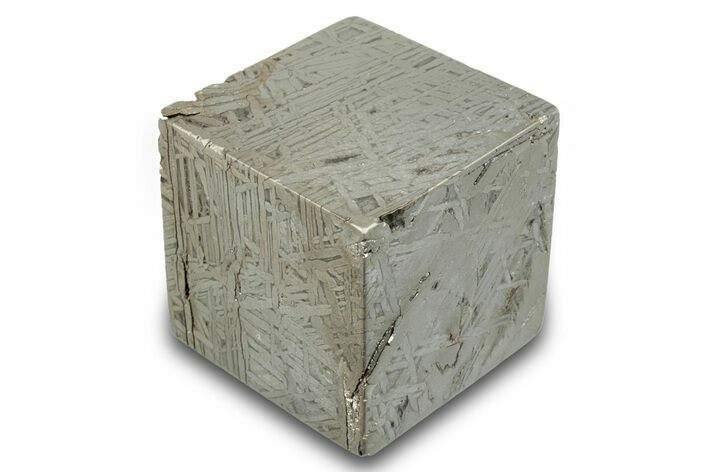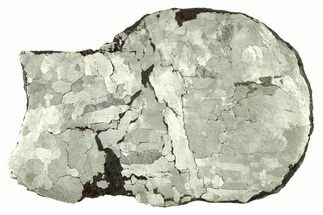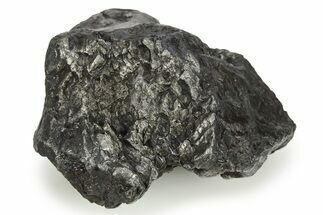1.5" Aletai Iron Meteorite Cube (383.3 g) - Xinjiang, China
This is a 1.5" wide (383.3 gram), etched cube of the Aletai iron meteorite discovered in the Xinjiang region of China. It has been acid etched to reveal the fascinating crystallization patterns within the meteorite. The cube has been stabilized and sealed to prevent rusting.
The Aletai Meteorite
The Aletai meteorite began as a massive meteor--estimated be up to 100 tons--that broke up upon entry into Earth's atmosphere, depositing meteorite fragments across China, some as massive as 28 tons. The strewn field was approximately 500 kilometers long. The shower of meteorite fragments were spread out over such a large area that specimens were given a variety of different names, primarily names of cities they were found near. It wasn't until studies determined that they all originated from the same event that they were either renamed or considered synonymous with Aletai.
The size of Aletai's strewn field has been attributed to entering Earth's atmosphere at a very low trajectory, basically skipping through our upper atmosphere like a stone skipping across a pond as the meteor broke up.
Aletai contains a relatively large amount of the element iridium. Iridium is found in much higher concentrations in meteorites than in the Earth's crust: the 66 million-year-old K-T Boundary, marking the extinction event that wiped out the dinosaurs, contains amounts of iridium on par with meteoritic concentrations. This inspired the notion that a massive meteorite impact 66 million years ago, now known as Chixculub, was responsible for the extinction of non-avian dinosaurs.
The Aletai meteorite began as a massive meteor--estimated be up to 100 tons--that broke up upon entry into Earth's atmosphere, depositing meteorite fragments across China, some as massive as 28 tons. The strewn field was approximately 500 kilometers long. The shower of meteorite fragments were spread out over such a large area that specimens were given a variety of different names, primarily names of cities they were found near. It wasn't until studies determined that they all originated from the same event that they were either renamed or considered synonymous with Aletai.
The size of Aletai's strewn field has been attributed to entering Earth's atmosphere at a very low trajectory, basically skipping through our upper atmosphere like a stone skipping across a pond as the meteor broke up.
Aletai contains a relatively large amount of the element iridium. Iridium is found in much higher concentrations in meteorites than in the Earth's crust: the 66 million-year-old K-T Boundary, marking the extinction event that wiped out the dinosaurs, contains amounts of iridium on par with meteoritic concentrations. This inspired the notion that a massive meteorite impact 66 million years ago, now known as Chixculub, was responsible for the extinction of non-avian dinosaurs.
About Iron Meteorites
Iron type meteorites are composed primarily of iron and nickel, and are the remnants of differential cores torn apart at the beginning of the solar system. These metallic meteorites are often the easiest to identify after millions of years post-impact because they are quite different from terrestrial material, especially when it comes to their mass-to-surface area ratio. They are exceptionally heavy for their size since iron is a high-density metal: this is also why the Earth's core is nickel-iron. As planets form, the densest metals form gravitational centers, bringing more and more material into their gravitational pull. In the solar system's rocky planets, these dense materials are most often nickel and iron.
Most iron meteorites have distinctive, geometric patterns called Widmanstätten patterns, which become visible when the meteorite is cut and acid etched. These patterns are criss-crossing bands of the iron-nickel alloys kamacite and taenite that slowly crystalized as the core of the meteorites' parent bodies slowly cooled. Such large alloy crystallizations for mover millions of years and do not occur naturally on Earth, further proving that iron meteorites come from extraterrestrial bodies.
Iron type meteorites are composed primarily of iron and nickel, and are the remnants of differential cores torn apart at the beginning of the solar system. These metallic meteorites are often the easiest to identify after millions of years post-impact because they are quite different from terrestrial material, especially when it comes to their mass-to-surface area ratio. They are exceptionally heavy for their size since iron is a high-density metal: this is also why the Earth's core is nickel-iron. As planets form, the densest metals form gravitational centers, bringing more and more material into their gravitational pull. In the solar system's rocky planets, these dense materials are most often nickel and iron.
Most iron meteorites have distinctive, geometric patterns called Widmanstätten patterns, which become visible when the meteorite is cut and acid etched. These patterns are criss-crossing bands of the iron-nickel alloys kamacite and taenite that slowly crystalized as the core of the meteorites' parent bodies slowly cooled. Such large alloy crystallizations for mover millions of years and do not occur naturally on Earth, further proving that iron meteorites come from extraterrestrial bodies.
TYPE
Iron (IIIE-an)
LOCATION
Xinjiang, China
SIZE
1.5 x 1.45 x 1.4", Weight: 383.3 grams
CATEGORY
SUB CATEGORY
ITEM
#276343
 Reviews
Reviews










